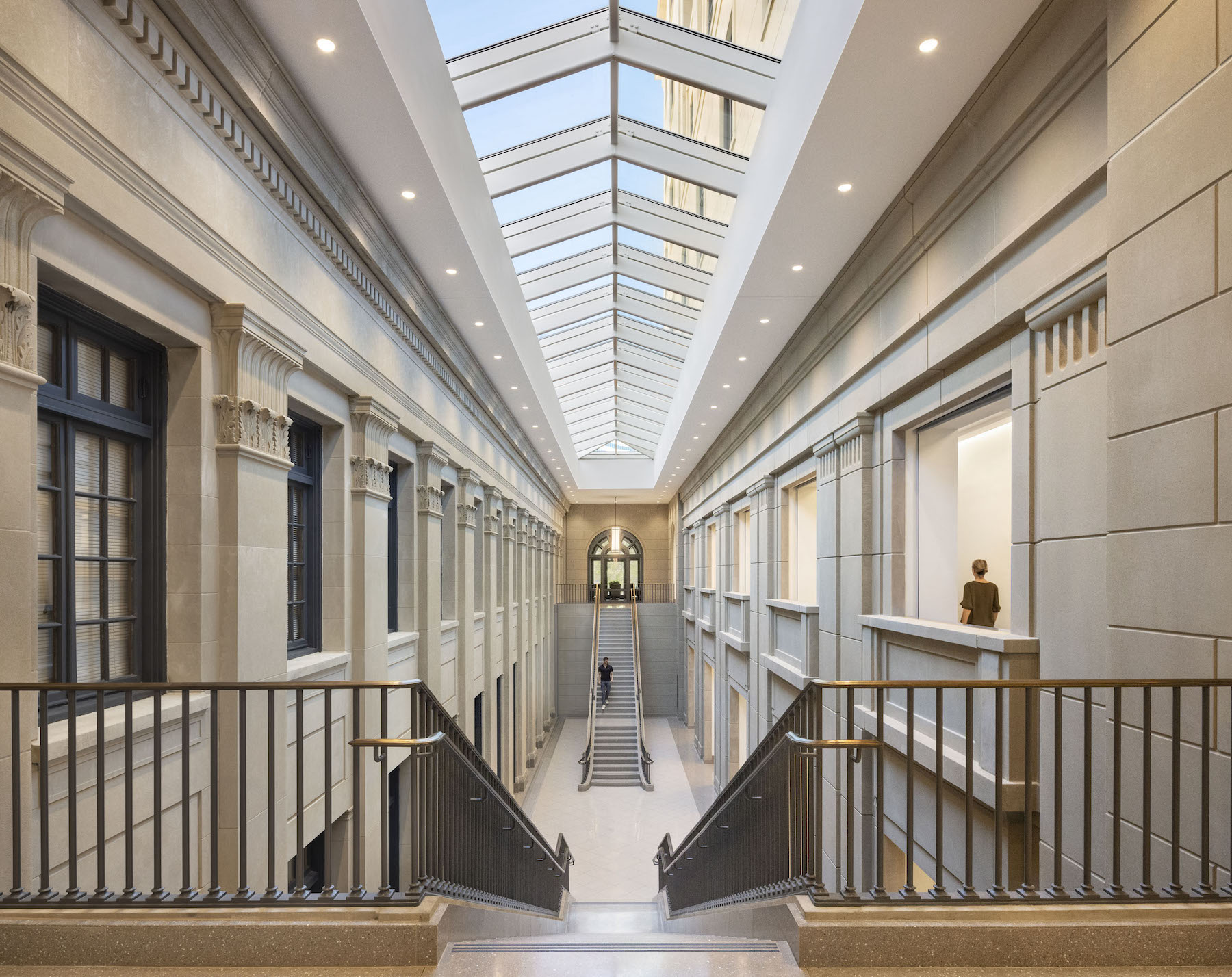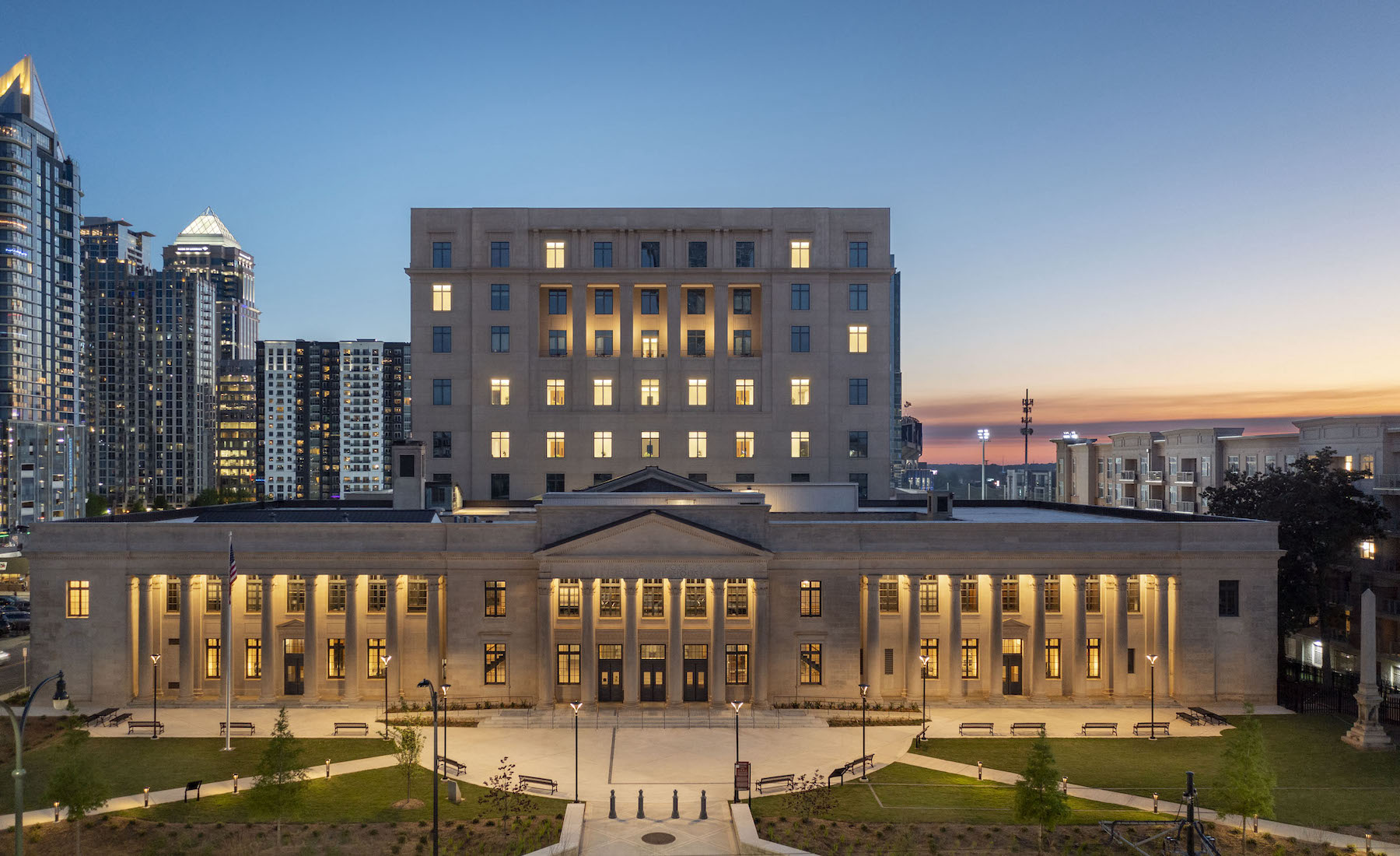The Charles R. Jonas Federal Building and Courthouse in Charlotte, N.C., is a historic Neo-classical edifice built in 1915. The building’s size was tripled in 1933. But more recently it has been badly in need of upgrading to 21st Century justice standards, especially in the areas of security, energy efficiency, and workspaces for support staff.
A Building Team that included the designer Robert A.M. Stern Architects and CGL Companies (which specializes in justice-related projects) recently completed a $164.7 million modernization and addition of an eight-story wing that accommodates nine new courtrooms, chambers, and support spaces. The new wing, which rises up behind the original building, maintains the courthouse’s Classical architectural presence along Charlotte’s skyline.

Unintrusive modernization of the Charles R. Jonas Federal Building and Courthouse
Charlotte-based Jenkins Peer Architects was AOR on this project, which was completed 11 months ago and had its ribbon cutting last May. fs3|Hodges was the CMa and Brasfield & Gorrie the CMc. The project added 195,719 sf, bringing the building’s total gross size to 315,685 sf. The new wing includes a top-floor Special Proceedings Courthouse and judges’ chambers. The addition is seeking LEED Gold certification.

Inside, a distinguishing feature is how the historic and new facades meet in a double-height stair hall inserted between the two structures. A skylight provides natural light from above the interiors. Outside, RAMSA created a two-story, lighted portico that mimics the columned front of the original building.
“We’ve successfully updated the Jonas Courthouse for the future without compromising on what has made it a treasured part of uptown Charlotte’s architectural fabric,” said Kevin Kelly, Partner at RAMSA, in a prepared statement. “For cities across the country, it’s an example of how significant and historic civic infrastructure can be modernized in a way that maintains a distinct character and presence.”
This project is the result of a 2012 examination by the U.S. Courts and General Services Administration for the potential reuse of the city-owned Jonas Courthouse to meet long-term housing needs. Charlotte agreed to a property exchange that returned ownership of the Courthouse to the GSA.
Related Stories
| Jun 2, 2014
Parking structures group launches LEED-type program for parking garages
The Green Parking Council, an affiliate of the International Parking Institute, has launched the Green Garage Certification program, the parking industry equivalent of LEED certification.
| May 29, 2014
7 cost-effective ways to make U.S. infrastructure more resilient
Moving critical elements to higher ground and designing for longer lifespans are just some of the ways cities and governments can make infrastructure more resilient to natural disasters and climate change, writes Richard Cavallaro, President of Skanska USA Civil.
| May 27, 2014
America's oldest federal public housing development gets a facelift
First opened in 1940, South Boston's Old Colony housing project had become a symbol of poor housing conditions. Now the revamped neighborhood serves as a national model for sustainable, affordable multifamily design.
| May 23, 2014
Top interior design trends: Gensler, HOK, FXFOWLE, Mancini Duffy weigh in
Tech-friendly furniture, “live walls,” sit-stand desks, and circadian lighting are among the emerging trends identified by leading interior designers.
| May 22, 2014
7 ways it pays to use BIM for data centers
Here’s where AEC firms and owners are getting the most bang for the buck when using BIM/VDC to coordinate data center projects.
| May 22, 2014
Big Data meets data centers – What the coming DCIM boom means to owners and Building Teams
The demand for sophisticated facility monitoring solutions has spurred a new market segment—data center infrastructure management (DCIM)—that is likely to impact the way data center projects are planned, designed, built, and operated.
| May 20, 2014
Kinetic Architecture: New book explores innovations in active façades
The book, co-authored by Arup's Russell Fortmeyer, illustrates the various ways architects, consultants, and engineers approach energy and comfort by manipulating air, water, and light through the layers of passive and active building envelope systems.
| May 20, 2014
Gensler envisions 'law firm of the future' with pop-up office project
Called "The Legal Office of the Future," the pop-up demonstration project made its debut this week at the annual conference for the Association of Legal Administrators in Toronto.
| May 19, 2014
What can architects learn from nature’s 3.8 billion years of experience?
In a new report, HOK and Biomimicry 3.8 partnered to study how lessons from the temperate broadleaf forest biome, which houses many of the world’s largest population centers, can inform the design of the built environment.
| May 13, 2014
19 industry groups team to promote resilient planning and building materials
The industry associations, with more than 700,000 members generating almost $1 trillion in GDP, have issued a joint statement on resilience, pushing design and building solutions for disaster mitigation.
















